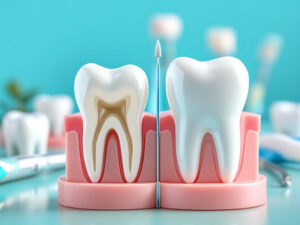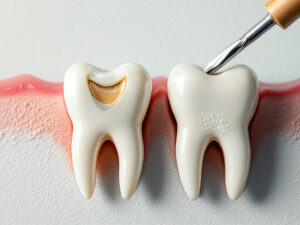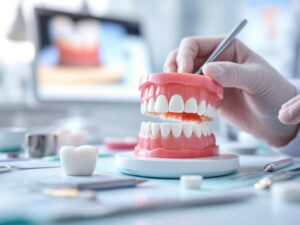Discover esthetic dental crowns
If you want to reclaim confidence in your smile without compromising on functionality, esthetic dental crown placement can be a transformative solution. By combining advanced materials with precise techniques, esthetic dental crowns help you achieve a seamless, natural-looking appearance while reinforcing the strength of your tooth structure. Whether you are concerned about discoloration, chipped enamel, or other cosmetic imperfections, esthetic crowns offer a helping hand in restoring both form and function to your teeth.
As a trusted family practice, Cloninger Dentistry focuses on personalized care that supports your unique oral health goals. A customized approach translates into greater comfort during treatment and more sustainable results. From porcelain crowns that blend flawlessly with surrounding teeth to proven aftercare methods that keep your new crown looking radiant, you can expect treatment tailored to your needs. By understanding every step of the process—including how crown materials differ, how they are placed, and what to expect long-term—you can gain greater confidence in your smile and protect it for years to come.
Explore crown material options
Esthetic dental crowns come in a broad range of materials that balance durability with appearance. Modern dentistry allows you to choose from ceramic, porcelain-fused-to-metal, zirconia, and even resin options. Each type not only addresses different functional requirements but also caters to specific cosmetic goals. Below is a closer look at some commonly used crown materials, highlighting their key attributes:
-
All-ceramic (Porcelain)
Ceramic crowns, particularly porcelain ones, are highly valued for their natural translucency. They mimic the reflective properties of real teeth, ensuring a lifelike look. As noted in a publication by DentalCare, ceramic restorations are aesthetically pleasing but require attentive patient care because of their brittle nature. If you grind your teeth (a condition known as bruxism) or have a strong bite, you may be guided toward a more fracture-resistant material—unless you incorporate protective measures, such as a night guard fabrication. -
Porcelain-fused-to-metal (PFM)
PFM crowns blend porcelain’s natural look with the strength of a metal substructure. While they deliver durability, one of the drawbacks can be a fine metal line showing at the gum line over time. Still, they remain a strong option if you require a robust crown that still retains some esthetic properties. -
Zirconia
Zirconia ceramics boast excellent strength, making them a popular choice for patients who desire both aesthetics and durability. According to research cited by Arboretum Dentist, zirconia stands out for its ability to withstand significant chewing forces, resulting in a longer average lifespan. In addition, zirconia can be milled and color-matched to blend in well with adjacent teeth. -
Resin or composite
For patients seeking a more budget-friendly option, resin or composite crowns might work well. While they can look natural, they are more prone to wear or staining compared to other materials. They are often used as short-term solutions—especially for front teeth not subjected to heavy biting forces.
By collaborating with an experienced team, you can explore which solution fits your lifestyle, cosmetic preferences, and budget. As every mouth is unique, the optimal result comes from personalizing your choice of material to your clinical needs and your goal of maintaining a radiant, natural smile.
Consider the placement process
The process for esthetic dental crown placement typically unfolds across a few straightforward steps. Understanding each one can help you stay calm, informed, and confident as you prepare for treatment:
1. Assessment and treatment planning
Your dentist begins by examining the tooth that needs a crown, using X-rays and other diagnostic tools. This assessment confirms whether a crown is indeed your best option, or if you might benefit from alternative solutions—such as porcelain veneer placement or a cosmetic bonding service—depending on the condition of your tooth and your overall smile goals. During the planning stage, you can also discuss sedation preferences, especially if you have any concern about dental anxiety. Cloninger Dentistry offers options like nitrous oxide sedation and sedation dentistry service to ensure your comfort throughout the procedure.
2. Tooth preparation
To create space for the crown, your dentist removes a small amount of enamel around the tooth’s surface. The thickness of the removal depends on the material chosen. For instance, porcelain crowns often require slightly more tooth reduction than metal crowns, since porcelain needs adequate thickness to achieve a natural shade without risk of fracture. If your tooth has extensive decay, a buildup material is used to restore enough structure for a stable crown placement.
3. Impression or digital scan
After shaping your tooth, an impression or digital scan is taken to capture the specifics of your bite and the tooth’s contours. Many modern offices now employ digital scanning techniques to create a three-dimensional model of your tooth. This technology can produce highly accurate representations in a shorter time frame and with less mess compared to traditional impression materials. The captured data then informs the design of your permanent crown.
4. Temporary crown
While your permanent crown is fabricated in a dental lab or via an in-office milling system, a temporary crown is usually placed over your prepared tooth. This protects the tooth from sensitivity or damage while also preserving its position in your mouth. You can expect to wear a temporary crown for a few days or weeks, depending on the complexity of your case.
5. Final crown placement
Once the permanent crown is ready, your dentist will remove the temporary, clean the prepared tooth, and bond or cement the new crown. A final evaluation of your bite and crown appearance ensures that the crown both feels comfortable and integrates well visually. The bonding technique used may differ depending on whether the crown is porcelain, zirconia, or another material. The end result is a tooth that looks much like its natural neighbors—restoring your smile’s symmetry and functionality.
Prevent complications with aftercare
Even the most expertly placed esthetic crown needs proper maintenance. Neglecting aftercare might lead to unforeseen complications such as gum irritation, decay around the margins, or early crown failure. Below are actionable tips to help you care for your new crown:
-
Brush and floss regularly. Despite being a restoration, your crown is still susceptible to plaque buildup along the gum line. This can lead to gum inflammation or cavities in the underlying tooth structure. Use gentle brushing motions around the crown margins, and consider floss designed for dental work to avoid snagging.
-
Attend follow-up appointments. Regular check-ups let your dentist verify the crown’s integrity and fit. According to Number Analytics, ongoing patient care ensures emerging issues such as minor debonding or small fractures can be managed before they become significant.
-
Avoid extremely hard foods. Although most modern crown materials are tough, they are not indestructible. Habitually chewing on very hard items like ice or unpopped popcorn kernels might crack or chip even the strongest crown. If you find yourself grinding at night, a night guard fabrication can help you protect your investment.
-
Monitor sensitivity. It is normal to feel some sensitivity immediately after crown placement, particularly to hot or cold foods. This usually eases within a few days. If sensitivity persists for more than a few weeks, consult your dentist for an evaluation of your tooth’s nerve health or the crown’s fit.
Adhering to these guidelines fosters long-term comfort and functionality. If you notice any abrupt changes—such as discomfort, swelling, or looseness—promptly contact your dentist for an evaluation.
Maximize crown longevity
One of the core reasons patients choose esthetic dental crown placement is the promise of a durable, lasting restoration. Professional vigilance and your own commitment to oral hygiene go hand in hand in achieving this longevity. Here are practical ways to extend the life of your crown:
Implement a consistent home care routine
Esthetic crowns often require the same diligent care as your natural teeth. Brushing at least twice a day using a soft-bristle toothbrush and fluoride toothpaste can reduce the risk of decay around the crown. Integrating daily flossing or using an interdental brush can remove food particles lodged between teeth, protecting the crown’s edges from plaque accumulation.
Schedule routine professional cleanings
Besides your daily routine, scheduling regular cleanings with your dentist offers more than a polished smile. Professional cleanings, which you might pair with a teeth whitening treatment or professional teeth whitening for an aesthetic boost, help remove tartar that can accumulate around crown margins. During these visits, your dentist or hygienist also monitors the crown, spotting early signs of wear, micro-fractures, or gum recession so you can address these issues proactively.
Consider protective dental appliances
For patients with bruxism or those who play contact sports, your teeth can face more pressure than average. If you frequently clench or grind your teeth overnight, a custom guard—such as a night guard fabrication—can cushion your teeth and distribute forces evenly, diminishing the risk of fracturing a crown. Similarly, if sports are a part of your lifestyle, a sports mouth guard fabrication ensures the crown and surrounding teeth remain shielded from impact.
Maintain a wholesome diet
Crowns function similarly to a healthy, natural tooth, so a good diet is essential to reduce excessive strain. Making moderate choices—like minimizing hard candy, performing gentle biting, and seeking a balanced intake of vitamins—can help your crowned teeth remain strong. Furthermore, consistent hydration with water assists in rinsing away acidic residues, lowering your risk of bacterial growth.
By integrating these steps, you offer your esthetic crown the support necessary for a long lifespan. Studies from Ultimate Smiles note that crowns can last anywhere from 5 to 15 years and sometimes stretch beyond two decades with impeccable care.
Benefit from a tailored approach
The success of an esthetic dental crown placement often emerges from a thoughtful, individualized treatment plan. In a supportive environment that recognizes your unique challenges, you gain access to a personalized strategy addressing shape, color, and function. Much like specialized rehabilitation programs that tailor interventions to specific needs, your dental care benefits from a focus on custom solutions.
- Personalized color matching: The crown’s shade is measured against neighboring teeth so that your treated tooth blends almost imperceptibly with your existing smile.
- Customized shape: Different people require specific tooth contours to preserve their bite balance. A thorough assessment ensures the final result suits your mouth’s natural alignment.
- Sedation for anxious patients: If you or a loved one experiences dental anxiety, sedation methods like iv sedation dentistry or sedation for anxious patients are available, minimizing discomfort or stress during the procedure.
- Comprehensive care add-ons: You might also combine crown placement with complementary services such as a laser gum contouring procedure or a cosmetic smile makeover to fully enhance your overall look.
Whether you are focusing on a single tooth or planning multiple improvements, an approach that addresses every element of your smile can help ensure lasting satisfaction. A practice that places strong emphasis on planning and collaboration gives you the assurance that every choice—from materials to sedation options—is made with your best interest in mind.
Choose Cloninger Dentistry today
Selecting the right dental team for your esthetic dental crown placement is as important as choosing the right crown material. At Cloninger Dentistry, you will find expertise, empathy, and a commitment to patient-centered care. Here is how we elevate your treatment experience:
-
Advanced technologies
Cloninger Dentistry employs up-to-date diagnostic and fabrication tools, which may include digital impressions to ensure high accuracy. These tools provide a more comfortable patient experience, reducing your time in the chair. -
Empathetic team
We understand the anxiety many people feel before a dental procedure. Our professionals are trained to soothe nerves and accommodate concerns while you are in the office. If you need extra reassurance, sedation options such as nitrous oxide sedation can help you remain at ease. -
Comprehensive services
Whether you require virtual dental consultation to discuss your crown candidacy or want to explore a porcelain veneer placement for adjacent teeth, we aim to provide a full spectrum of services. From pre-treatment planning to post-treatment follow-up, our practice supports you at each step. We also offer elective enhancements such as laser skin rejuvenation and facial aesthetics consultation, reflecting our commitment to your overall well-being and confidence. -
Flexible scheduling
We recognize that life is busy, which is why we offer afterhours dental appointment or weekend dental appointment availability. This flexibility helps you stay on top of oral health without significant disruption to your schedule. -
Custom solutions for every age
From implant supported dentures to night guard fabrication, Cloninger Dentistry meets the needs of different generations. Our practice welcomes all family members, making it easier to coordinate visits and maintain a consistent level of care.
By integrating cutting-edge dentistry with a compassionate approach, Cloninger Dentistry strives to address each concern you have about comfort, scheduling, and overall satisfaction. We believe every patient deserves an environment that promotes trust and fosters optimism about the improvements you can achieve.
Frequently asked questions (FAQs)
1. How long does an esthetic dental crown typically last?
An esthetic dental crown can last anywhere from 5 to 15 years, and sometimes beyond 20 years with consistent home care and routine dental check-ups. Factors influencing longevity include the material chosen, your dietary habits, and your commitment to maintaining a regular brushing and flossing routine.
2. Does the crown placement procedure hurt?
You may experience mild pressure or vibrations during crown preparation, but most people find it relatively comfortable. Local anesthesia is used to numb the area, and additional sedation, such as sedation dentistry service, is available if you feel anxious. After the procedure, minor sensitivity is possible for a few days while the tooth adjusts.
3. How do I know if I should choose a veneer instead?
Veneers and crowns serve different purposes. Veneers cover only the front surface of the tooth and are ideal for addressing cosmetic issues such as small chips, discolorations, or minor shape concerns. Crowns encase the entire tooth and offer better reinforcement when significant structural damage or decay has occurred. A cosmetic dental evaluation can help determine which option suits your situation.
4. Will my new crown look like my natural tooth?
Yes. Modern crown materials—especially porcelain and zirconia—are engineered to replicate the appearance of natural teeth. Dentists take factors such as your tooth’s shape, shade, and translucency into consideration. This attention to detail produces a restoration that seamlessly matches the rest of your smile.
5. Are crowns covered by insurance?
Dental insurance coverage varies based on your specific plan. Many policies cover at least part of the cost of crowns if they are deemed medically necessary (for example, restoring a damaged tooth). Cosmetic procedures that lack a restorative function may not be fully covered. Checking with your insurance provider—or discussing it during your treatment planning consultation—gives you a clearer idea of what costs to expect.
Esthetic dental crown placement can be a practical and versatile choice for patients wishing to enhance both appearance and function. By staying informed about your options, prioritizing comprehensive aftercare, and partnering with a caring dental team such as Cloninger Dentistry, you improve your chances of enjoying a bright, revitalized smile that aligns perfectly with your goals. Feel free to reach out to us today for a personalized consultation and explore the possibilities we can offer on your path to better oral health.










